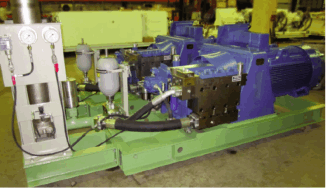The use of efficient, high-pressure pumps is becoming more common in mining and similar activities where there is a requirement for robust and reliable pumping systems to perform crucial tasks. However, just looking at price and specification may not reveal the full range of benefits available from the various manufacturers and the potential costs or savings, which could be encountered further down the line.

According to pump builder RMI Pressure Systems, specifying the right high-pressure pump model can yield significant energy savings, but it is also important to understand how the design and operation of each unit can affect costs over the lifetime of the pump in order to calculate total savings accurately.
Recently, Mike Sherman, marketing manager at U.K.-based RMI Pressure Systems, offered advice on how the specific design of a pump affects the ease of installation as well as the overall reliability.
With rising energy costs across the world, most industries are reviewing applications, which depend on high energy consumption, with a view to using more energy efficient equipment. For those involved in the procurement of new, more efficient equipment in these and other industries, the performance and reliability of a potential purchase must be demonstrated.
The use of positive displacement pumping systems can often deliver instant savings over rotary pumps simply by being more efficient and requiring less power to run the process. By reducing the motor size, improving reliability and overall efficiency, the savings in power consumption can reach 40% with the additional benefit of less downtime and maintenance time—all of which help in improving overall profit.
However, understanding the benefits of individual pump designs is also important to ensure that the most suitable plant is installed. The equipment will not only affect those responsible for paying the bills, but also the maintenance engineers and operators who will be responsible for the day-to-day running.
One example would be the method of connecting the motor to the pump, which, in the majority of cases, is done using a coupling, with the components mounted on a base plate. This design can result in possible twisting loads in the event of a locked pump, which translates into a requirement for improved mounting security to ensure the pump assembly remains in place. It is important that the calculations for these twisting moments are made carefully and precisely to ensure that a locked pump does not lead to additional damage.
However, a design by RMI Pressure Systems meets the most stringent reliability tests and provides efficient delivery without the need for these additional engineering calculations. The key to this benefit is the design of the solid, centralized pedestal, which supports both the motor and the pump by being bolted directly to the pedestal. This design means that any torque moment transfer to the bedplate anchors will be negligible.
RMI includes a number of safety circuits to prevent a potential locked shaft condition, including a pump safety relief valve, which protects the pump against a potential hydraulic lock. In addition, there are oil temperature and pressure sensing circuits as well as motor overload monitoring, all of which can indicate a potential issue with the system and allow the pump to be stopped prior to any potential damage being caused. But additional security in the centralized pillar means that in the event of a locked pump, costly downtime and repair bills can be avoided.
Further benefits offered by RMI’s design include the stored energy offloading system, which allows the pump to idle in a pressurized standby condition, while still being able to quickly and efficiently return to full service when required; reducing energy consumption. This alternative to complex by-pass, drain or accumulator systems allows the pump to run without generating further pressure while allowing system flow and pressure to be maintained when required.
Specifying the right high-pressure pumping system can help to make significant energy savings, Sherman concluded; however, it is also important to understand how the design and operation of each product can affect the costs over the lifetime of the pump in order to calculate savings accurately. The design of any new equipment should be such that the installation process is as simple as possible and the daily operation reliable and efficient. With the ability to create bespoke high-pressure pumping solutions, RMI claims to deliver a system ready to be integrated into the existing infrastructure and immediately deliver savings to the client.









